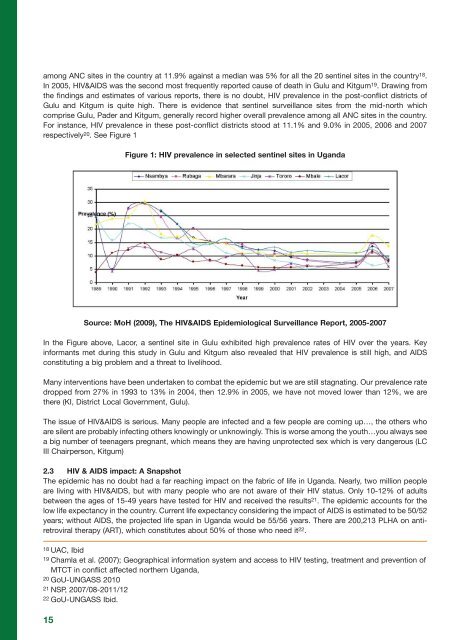Uganda Report 2012 FINAL PO:Layout 1 - ACORD
Uganda Report 2012 FINAL PO:Layout 1 - ACORD
Uganda Report 2012 FINAL PO:Layout 1 - ACORD
You also want an ePaper? Increase the reach of your titles
YUMPU automatically turns print PDFs into web optimized ePapers that Google loves.
among ANC sites in the country at 11.9% against a median was 5% for all the 20 sentinel sites in the country 18 .<br />
In 2005, HIV&AIDS was the second most frequently reported cause of death in Gulu and Kitgum 19 . Drawing from<br />
the findings and estimates of various reports, there is no doubt, HIV prevalence in the post-conflict districts of<br />
Gulu and Kitgum is quite high. There is evidence that sentinel surveillance sites from the mid-north which<br />
comprise Gulu, Pader and Kitgum, generally record higher overall prevalence among all ANC sites in the country.<br />
For instance, HIV prevalence in these post-conflict districts stood at 11.1% and 9.0% in 2005, 2006 and 2007<br />
respectively 20 . See Figure 1<br />
Figure 1: HIV prevalence in selected sentinel sites in <strong>Uganda</strong><br />
Source: MoH (2009), The HIV&AIDS Epidemiological Surveillance <strong>Report</strong>, 2005-2007<br />
In the Figure above, Lacor, a sentinel site in Gulu exhibited high prevalence rates of HIV over the years. Key<br />
informants met during this study in Gulu and Kitgum also revealed that HIV prevalence is still high, and AIDS<br />
constituting a big problem and a threat to livelihood.<br />
Many interventions have been undertaken to combat the epidemic but we are still stagnating. Our prevalence rate<br />
dropped from 27% in 1993 to 13% in 2004, then 12.9% in 2005, we have not moved lower than 12%, we are<br />
there (KI, District Local Government, Gulu).<br />
The issue of HIV&AIDS is serious. Many people are infected and a few people are coming up…, the others who<br />
are silent are probably infecting others knowingly or unknowingly. This is worse among the youth…you always see<br />
a big number of teenagers pregnant, which means they are having unprotected sex which is very dangerous (LC<br />
III Chairperson, Kitgum)<br />
2.3 HIV & AIDS impact: A Snapshot<br />
The epidemic has no doubt had a far reaching impact on the fabric of life in <strong>Uganda</strong>. Nearly, two million people<br />
are living with HIV&AIDS, but with many people who are not aware of their HIV status. Only 10-12% of adults<br />
between the ages of 15-49 years have tested for HIV and received the results 21 . The epidemic accounts for the<br />
low life expectancy in the country. Current life expectancy considering the impact of AIDS is estimated to be 50/52<br />
years; without AIDS, the projected life span in <strong>Uganda</strong> would be 55/56 years. There are 200,213 PLHA on antiretroviral<br />
therapy (ART), which constitutes about 50% of those who need it 22 .<br />
18 UAC, Ibid<br />
19 Chamla et al. (2007); Geographical information system and access to HIV testing, treatment and prevention of<br />
MTCT in conflict affected northern <strong>Uganda</strong>,<br />
20 GoU-UNGASS 2010<br />
21 NSP, 2007/08-2011/12<br />
22 GoU-UNGASS Ibid.<br />
15





